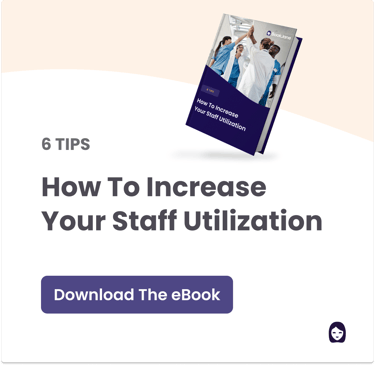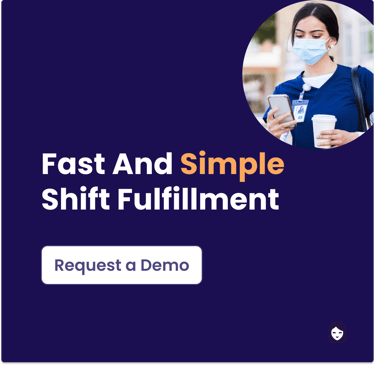
Accelerating Staff Recovery With Technology
For the already strained senior-care sector, the arrival of COVID-19 was a hard blow. The long hours and high stress of the pandemic turned what was already a staffing crunch into an all out crisis, one that required major innovation in order for the industry to thrive.
With staff tenure measured in months, not years, and 43% of workers leaving the industry due to burnout, it was essential to find new ways to optimize the scheduling process in senior care. Efficiency was crucial, and organizations not making full use of their existing staff were forced to pay high penalties in the form of overtime hours and agency fees.
Technology was, and continues to be, the solution to the industry’s woes. With an aging population, less workers, and continuous demands for shifts, a better way of scheduling can not only alleviate burnout and worker turnover, it can also help your organization become more efficient overall. More demand for services and less supply of staff could cause a crisis — or it could accelerate your recovery, making your organization more agile, more informed, and more efficient than ever before.
Here are three ways staff recovery can be accelerated using technology:
1. Technology can Prevent Burnout and Reduce Turnover
Unlike a manual process, scheduling using technology leads to making better use of your existing workforce. Former methods of scheduling relied heavily on calling the same people in to work, having understaffed shifts, or relying on agency hired. This leaves little transparency for your staff, who are not only unsure of when they’ll be working next, but also scrambling to show up to shifts without key team members or with workers new to the facility.
All of this adds up to plenty of stress. Research into Ontario’s long term care homes suggest that almost half of the workers leaving the industry are doing so due to burnout. However, the majority of long term care workers do their work because of the satisfaction and meaning that they find in it — the lowest ranked factor for leaving senior care is the patients and families themselves.
The nature of personal care work means workers often form bonds with residents, making it more difficult when they have to show up to work tired, stressed, or run off their feet. While care workers find meaning in the services they provide to their residents, they don’t want to work long hours or stressful shifts. When they do, they can feel hamstrung in their ability to provide the best care possible, leaving them discouraged and underappreciated at the end of the day.
Technology can be useful for preventing this. In addition to making better use of your existing staff (such as by automating the call out process and spreading more of your workload out across your organization), scheduling tech can also be used to add transparency.
By automating the process used to fill shifts, administrators can adhere to union rules about staff priority, labor laws around how many workers are required per resident, and provide flexibility to staff (for example, by offering up a free shift by email so staff can schedule themselves at their leisure). It can also accurately forecast labor needs, so that the organization is able to tell which shifts are hardest to fill and where they’re paying the most in overtime.
2. Technology can Streamline Scheduling and Last Minute Shift Fulfillment
Scattered methods of scheduling (for example, having a central schedule for the week in addition to manually calling in shifts) can lead to confusion and inefficiency. Technology can help with this process, centralizing scheduling into one place, where staff will always know whether or not they’re working, which shifts are available, and how many people are working with them.
This leads to more consistency in the work environment — involving existing staff before reaching out to agency hires can mean more stability in who is on the floor and at what time. It can also mean more accurately forecasting labor requirements, more staff-patient interaction, and more consistency in the provision of care.
When staff call out at the last minute due to illness, school closures, or any of the other factors occurring both before and after the pandemic, administrators are no longer scrambling to fill the place. Automation not only gives staff the chance to pick up their own shifts at their leisure, it also gives them more certainty that the shift they will be working on will be fully staffed with workers who are familiar with the facility, the protocols, and the residents.
3. Technology can Help with Strategic Staffing
One of the best ways technology can benefit your business is through the generation of data. By generating data on when your staff work, when they call out, and when you’re paying the most for overtime or agency hires, you can better predict what your workforce is going to look like in the future.
In this way, you can use strategic staffing methods to lower costs. For example, in addition to increasing productivity — since your staff are spending more time with your residents and not training new staff or trying to keep up — administrators and management can use future predictions to foresee when incentives will be needed to fill shifts, and when the shift itself is enough. Part time staff often want the hours, especially at the same facility, and given that the industry is staffed by so many part time team members, this can save your full time workers a lot of time and hustle.
The cost savings generated by using an automatic staffing technology can then be reinvested in other areas of the business, helping your organization to provide a better quality of care —- and of life — for your residents. Data can point you towards areas to improve in the future, and existing methods of hiring, staffing, and training, can all be modified to suit the new paradigm.
All of this leads your organization to be much more productive than it was before.
Whether you’re running a large care facility as part of a network of care organizations or manning a small, family owned fund, technology is the key to breaking past barriers to fair and safe staffing for both you and your residents. When you reduce burnout, turnover, and overstaffed shifts, you make it easier for your employees to do the work that they love — with less stress.





